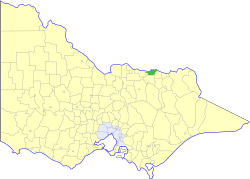
Rutherglen is a town in north-eastern Victoria, Australia, near the Murray River border with New South Wales. The town was named after the Scottish town of Rutherglen which lies just outside Glasgow. At the 2021 census, Rutherglen had a population of 2,579.

Wahgunyah is a town in northeastern Victoria, Australia. The town is on the southern bank of the Murray River, opposite Corowa, New South Wales, in the Shire of Indigo. Wahgunyah is 298 kilometres (185 mi) north east of the state capital, Melbourne and 51 kilometres (32 mi) west of Albury/Wodonga. At the 2016 census, Wahgunyah had a population of 1,098.
The Coreen & District Football League was an Australian rules football competition in the Coreen district of the Riverina in New South Wales, initially formed in 1909. The netball competition commenced in 1972 in line with the football fixture. The league was disbanded at the end of the 2007 season after 99 years of competition.

The Ovens and Murray Football Netball League is an Australian rules football and netball competition containing ten clubs based in north-eastern Victoria, the southern Riverina region of New South Wales and the Ovens and Murray area. The name comes from the Ovens River, the river in the part of north-eastern Victoria covered by the league, and the Murray River, which separates Victoria and New South Wales.

The Rutherglen Football and Netball Club is an Australian rules football and netball club playing its home games in Rutherglen, Victoria, Australia. The current Rutherglen FNC was created after the merger of Ovens & Murray Football League sides Rutherglen and Corowa in 1979. Surplus players from the new Corowa-Rutherglen club reformed Rutherglen and played in the Coreen & District Football League for 13 years.

The Shire of Rutherglen was a local government area about 275 kilometres (171 mi) north-northeast of Melbourne, the state capital of Victoria, Australia. The shire covered an area of 530.9 square kilometres (205.0 sq mi), and existed from 1862 until 1994.
John Frederick Hiskins was an Australian rules footballer who played for Essendon in the Victorian Football League (VFL) during the early 1900s.

The Wahgunyah railway is a closed line in north-east Victoria, Australia. Branching off the main North East railway at Springhurst, it ran north-west to Wahgunyah.

Springhurst is a town in north-eastern Victoria, Australia. It is in the Rural City of Wangaratta local government area, 280 kilometres (170 mi) north east of the state capital and 16 km from the city of Wangaratta. At the 2016 census, Springhurst and the surrounding area had a population of 348.

The Albury Football Club, nicknamed the Tigers, is an Australian rules football and netball club based in Albury, a major regional city in New South Wales. Albury football and netball squads compete in the Ovens & Murray Football League.
The Corowa Football Club, nicknamed the Spiders, was an Australian rules football club based in Corowa, New South Wales, that competed in the Ovens & Murray Football League.

Richard Thomas Ball was a politician and engineer in New South Wales, Australia.
George Sutherland Smith was a Scotsman who migrated to Australia, working as a builder and paddle-steamer captain. He turned to winemaking with considerable success, founding the All Saints winery in the Rutherglen region of Victoria.

The Corowa Flour Mill is a heritage-listed former flour mill and now tourist attraction at Steel Street, Corowa, in the Riverina region of New South Wales, Australia. It is also known as the Corowa Flour Mill and site. It was added to the New South Wales State Heritage Register on 2 April 1999.

The Corowa Courthouse is a heritage-listed courthouse located at 8 Church Street, Corowa, in the Riverina region of New South Wales, Australia. It was designed by James Barnet, the Colonial Architect, and built from 1886 to 1887 by W. Squires. It is also known as the Corowa Court House. The property is owned by the Department of Justice, an agency of the Government of New South Wales. It was added to the New South Wales State Heritage Register on 22 December 2000.

The Corowa railway station is a heritage-listed railway station located on the Culcairn-Corowa line at Corowa, in the Riverina region of New South Wales Australia. It is also known as Corowa Railway Station and yard group. The property was added to the New South Wales State Heritage Register on 2 April 1999.
The Rutherglen Football Club was an Australian rules football club based in Rutherglen, Victoria, being a founding member of the Ovens & Murray Football League in 1893. In 1979, the club merged with Corowa to form the Corowa-Rutherglen FC, joining the Ovens & Murray Football League.
Wahgunyah Football / Netball Club is an Australian Rules Football club based in North Eastern Victoria that currently competes in the Tallangatta & District Football League.

Mount Boppy Gold Mine was a gold mine at Canbelego, New South Wales, Australia. The original Mount Boppy Gold Mine operated from 1901 to 1922. It was, at the time, regarded as being the largest gold producer in New South Wales.
Reno is a rural locality in the Cootamundra–Gundagai Regional Council local government area of the Riverina region, of New South Wales, Australia. There was once a gold mining village of the same name. For many years, until at least 2016, the locality was known as Jones Creek. Its population at the 2021 census was 131.
















